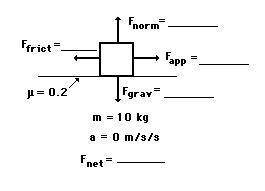
A rightward force is applied to a 10-kg object to move it across a rough surface at constant velocity. The coefficient of friction between the object and the surface is 0.2. Use the diagram to determine the (A) gravitational force, (B) normal force, (C) applied force, (D) frictional force, and (E) net force. (Neglect air resistance.)


Answers: 3


Another question on Physics

Physics, 21.06.2019 22:50
Two horizontal plates with infinite length and width are separated by a distance h in the z direction. the bottom plate is moving at a velocity u. the incompressible fluid trapped between the plates is moving in the positive x-direction with the bottom plate. align gravity with positive z. assume that the flow is fully-developed and laminar. if the systems operates at steady state and the pressure gradient in x-direction can be ignored, do the following: 1. sketch your system 2. identify the coordinate system to be used. 3. show your coordinates and origin point on the sketch. list all your assumptions. 5. apply the continuity equation to your system. nts of navier stokes equations of choice to your system 7. solve the resulting differential equation to obtain the velocity profile within the system make sure to list your boundary conditions. check units of velocity 8. describe the velocity profile you obtain using engineering terminology. sketch that on the same sketch you provided in (1). 9. obtain the equation that describes the volumetric flow rate in the system. check the units.
Answers: 2


Physics, 22.06.2019 06:30
Which one of the following research methods can show cause and effect
Answers: 1

Physics, 22.06.2019 08:40
An isolated conducting spherical shell carries a positive charge. part a which statement (or statements) about the electric field and the electric potential inside and outside the spherical shell is correct? which statement (or statements) about the electric field and the electric potential inside and outside the spherical shell is correct? electric potential inside the shell is constant and outside the shell is changing as 1/r2 both the electric potential and the electric field does change with r inside and outside the spherical shell electric potential inside and outside the shell is constant, but not zero electric potential inside the shell is constant and outside the shell is equal to zero electric field inside and outside the shell is constant (does not change with the position r), but is not equal to zero electric field inside and outside the shell is changing as 1/r (where r is the distance from the center of the sphere) electric field inside is equal to zero and outside the shell is constant, but not zero electric potential inside the shell is constant and outside the shell is changing as 1/r electric field inside and outside the shell is changing as 1/r2 electric field inside is equal to zero and outside the shell is changing as 1/r2 electric field inside and outside the shell is zero electric field inside is constant and outside the shell is changing as 1/r
Answers: 3
You know the right answer?
A rightward force is applied to a 10-kg object to move it across a rough surface at constant velocit...
Questions


Mathematics, 22.01.2021 23:30



Law, 22.01.2021 23:30

Mathematics, 22.01.2021 23:30

History, 22.01.2021 23:30

Engineering, 22.01.2021 23:30


Mathematics, 22.01.2021 23:30

Mathematics, 22.01.2021 23:30

Mathematics, 22.01.2021 23:30


History, 22.01.2021 23:30

Biology, 22.01.2021 23:30


Mathematics, 22.01.2021 23:30



Mathematics, 22.01.2021 23:30

 so
so

